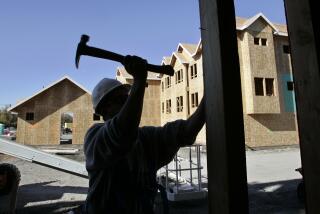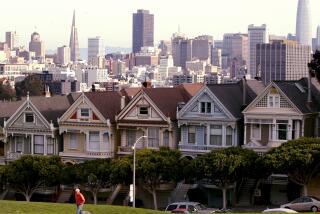Capitol Journal: Why the Legislature probably can’t fix California’s affordable housing problem
- Share via
Reporting from Sacramento — State lawmakers can pass all kinds of bills aimed at building more affordable housing. But they can’t repeal the fundamental law of supply and demand for desirable land.
Land costs are what really drive up housing prices and make homeownership increasingly beyond the reach of so many Californians. Rentals are virtually impossible, too, in attractive regions along the coast, especially San Francisco.
Land prices on the coast are among the highest in the nation. A residential acre in the average U.S. metropolitan area is valued at $20,000, the Legislative Analyst’s Office reported two years ago. Along California’s urban coast, an average acre is worth more than $150,000.
Sure, you can buy or rent homes relatively cheaply in gritty little towns off Interstate 5 in the San Joaquin Valley. Inland land prices in California are typically below the national average, the analyst reported.
But there aren’t many job opportunities on the San Joaquin Valley’s west side, except for picking crops. And during the drought, there was a serious shortage of drinking water in some places. It had to be trucked in. Wells ran dry.
The jobs are in the Bay Area, where it’s practically impossible for a middle-class family to move. The median selling price for a single-family home in San Francisco during July was $1.4 million, according to the California Assn. of Realtors.
In Los Angeles County, the median price was $566,000. In San Diego: $613,000. San Bernardino County had the lowest price in Southern California: $266,000.
So it’s not the lumber, labor and bathroom fixtures that mostly run up housing costs. It’s the desirable land. But that other stuff costs a lot, too.
The legislative analyst reported that materials, labor and government fees all are higher in California than the rest of the country. And regulations can tie up developers’ projects agonizingly for years, adding cost.
Then there’s the transportation quagmire.
Unlike New York, Chicago and Washington, D.C., where someone can live far out in the burbs and commute by rail to a job in the city, a resident of Palmdale or Modesto may need to drive 90 minutes to work, then back home at night. That can be a home wrecker.
A half century ago, when California had fewer than 20 million people, you could buy a three-bedroom, two-bath home in Sacramento for less than $20,000. Today, with the state’s population doubled, the same house would cost 10, 15 or 20 times as much, depending on the location.
We’ve just got too many people packed into livable areas. To sustain the population growth and return housing to semi-affordability in California, we’ll need to stack people on top of each other in cities, as Manhattan does. That goes against the grain of California’s revered ranch-style living. But it’s inevitable.
Want a suburban or country lifestyle? Then we’ll need to greatly upgrade our commuter rail system. That doesn’t mean a bullet train. It means usable, dependable regional rail.
So this is a long way of expressing skepticism about the Legislature’s current effort to pass an effective affordable housing package. That said, the lawmakers deserve credit for at least trying.
There are a few things that legislators — at least the Democrats — are trying to do while working within the parameters of what Gov. Jerry Brown will accept.
They want to create some permanent funding to help finance affordable housing. This is the toughest task because it involves raising revenue and that requires a two-thirds majority vote.
Lawmakers are about maxed out on politically risky revenue-raising this year. They previously increased gasoline prices to pay for road repairs and extended cap-and-trade polluter fees that will boost some consumer prices.
SB 2, by Sen. Toni Atkins (D-San Diego), would impose a $75 fee on real estate documents such as deeds and liens, raising around $250 million a year. It would affect mortgage refinancing, but not real estate sales.
SB 3, by Sen. Jim Beall (D-San Jose), is a proposed $3-billion bond issue to help fund affordable housing. It would go on the 2018 state ballot.
State Treasurer John Chiang, who’s running for governor, thinks that’s too miserly. He advocates going “big and bold” with a bond from $6 billion to $9 billion.
“The lack of affordable housing is a major risk to California’s economic prosperity,” Chiang told me. “We did a poll and 63% of voters have a close family member or friend who has moved away from California because of increased housing costs.”
“I’m trying to build up passion in the Senate,” said the mild-mannered Chiang.
“The reason the bond is not bigger is that the governor says, ‘That’s it!’” Beall told me. “He’s agreed to a $7 billion total for all bonds.”
Democrats also hope to pass a water-and-parks bond issue of nearly $4 billion.
Brian Dahle to replace Chad Mayes as Assembly GOP leader »
Another thing the Legislature wants to do about affordable housing is to streamline the regulatory process, speeding up development and lowering costs.
SB 35, by Sen. Scott Wiener (D-San Francisco) would eliminate many local restrictions in communities that have not been meeting their required housing goals.
“We have a housing shortage that is threatening California’s economy, diversity and environment,” he says. The working class is being pushed out of urban areas and their longer commutes are worsening climate change, he explains.
To fix all this will require changing California’s lifestyle — unless millions decide to flee the state.
Follow @LATimesSkelton on Twitter
ALSO
Don’t be too smug, California: The state has its own shameful history of racism and bigotry
More to Read
Get the L.A. Times Politics newsletter
Deeply reported insights into legislation, politics and policy from Sacramento, Washington and beyond. In your inbox three times per week.
You may occasionally receive promotional content from the Los Angeles Times.











